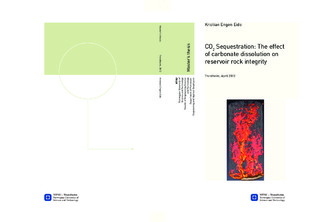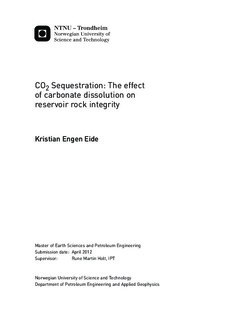| dc.description.abstract | Since the environmental focus only becomes stronger and stronger in today’s society, industries like the oil and gas sector face some difficult challenges. Being the primary industry for CO2 production in the world requires them to invest a lot of resources in finding alternative methods to prevent venting to the atmosphere. Governments around the world are initiating measures and imposing taxes in order to compel the companies to do this. Injecting CO2 for EOR purposes has been around for several decades and is very well known to the industry. However, in more recent years, the idea of injecting CO2 for storage has become a promising method. Currently, there are several ongoing Carbon Capture and Storage (CCS) projects around the world, with more to come. The idea is to inject the CO2 into depleted reservoirs of aquifers, allowing different trapping mechanisms to react with the CO2 and prevent it from reaching the surface. CO2 features the ability to form an acid when dissolved in brine. At high pressures, the acid is very aggressive and could induce a strong dissolution reaction with carbonates. This could lead to severe consequence in a CCS project since carbonates are common material in oil and gas reservoirs. Dissolving the reservoir rock could increase the porosity. The fact that the rock’s stiffness and strength are strongly related to its porosity implies that alteration of the porosity could have a softening and weakening effect on the stiffness and strength in terms of softening and weakening. In addition to the porosity increase, other effects, such as chemical effects, can also be present, contributing to further alteration of the rock. In the assessment of CCS projects, geomechanical modeling requires input data describing the effects that the acid has on the rock mechanical properties. A correct representation of the reservoir requires a comprehensive understanding of every aspect. This requires a lot of research and studies on the rock mechanical alteration. Simulating subsurface processes in the laboratory is the first difficult challenge that has to be solved. Wormhole formation is dominates the dissolution pattern when acidic solutions are injected into core samples, but this is considered to be less representative for the reservoir processes, as a more homogeneous dissolution is assumed. The current project has successfully established that injecting a retarded acid allows full saturation before reaction takes place. Pre and post CT scanning has been performed together with special core analysis and mercury injection capillary pressure (MICP). A significant increase in porosity is seen in the tested rock material, Euville limestone, as a result of the treatments using retarded acid. After 6 treatments, an increase of 3 porosity units is observed. The study has emphasized the effect that chemical dissolution has on the rock mechanical properties, in terms of stiffness and strength. Failure tests have been performed for determining the Mohr – Coulomb failure envelope after a certain degree of alteration. Beside from the porosity increase, it also follows that the acid exposure also affects the stiffness and strength. A significant change is observed in the Young’s modulus, bulk modulus, shear modulus and Poisson’s ratio, having an average change of 9.4 ± 3.6 GPa, 1.8 ± 2.7 GPa, 4.5 ± 1.2 GPa and 0.12 ± 0.04, respectively, after 6 acid treatments. The failure line, for the treated rock, shows a clear reduction in strength with a 77 % decrease in the friction angle and a 26 % decrease in uniaxial compressive strength. Intuitively, since porosity, stiffness and strength are closely related, most of the effect is caused by the porosity increase. However, there are indications of that also other effects are causing the evolution for the stiffness parameters to deviate from the stiffness–porosity trends. The study has also approached the assessment of rock alteration from an acoustic velocity point of view. Increasing the porosity also results in reduced P- and S-wave velocities, as expected. Deviation from the porosity trend does, however, also suggest, that other effects influence the acoustic properties, in addition to the porosity increase. An evaluation of the dynamic moduli shows that fluid substitution is only effecting the measurements to a minor extent. The established protocol is necessary for further studies of the rock mechanical alteration that CO2 induces as it is injected into the reservoir. Our findings are important steps toward implementing knowledge on how the reservoir is affected by CO2 injection into geomechanical models and seismic monitoring. Being able to predict possible consequences and outcomes as well as monitoring of the reservoir, are very important tools for CCS projects and could potentially be the key to the license to operate. | nb_NO |

